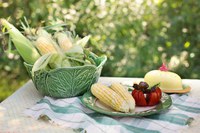Prairie Fare: Enjoy seasonal corn at its peak freshness
(Click an image below to view a high-resolution image that can be downloaded)
I remember writing one of my first food stories when I was quite young. I had just learned how to print.
As I picked corn in a friend’s corn field, I noted that many of the corn cobs had a couple bites missing. My story was titled “The Mystery in the Cornfield.”
Who or what had taken bites from the corn? This was quite a compelling story, to a child anyway.
I learned that sneaky masked animals were the culprits. I probably missed a couple letters in the word “raccoon.”
When we returned home after picking bushels of corn, we always had some corn on the cob to celebrate the harvest.
I especially enjoyed capping my teeth with the shiny yellow kernels at the dinner table. Although playing with our food was not advised, my family laughed at my golden smile.
What could our friend have done to evade the intruding animals? Interestingly, raccoons do not like squash. Some gardeners plant a perimeter of squash as a natural raccoon repellent. Raccoons do not like the prickly hairs on squash.
Corn plays a major role in the economy, and many types of corn are grown. “Dent” corn also is called “field corn.” It is low in sugar and high in starch, and it is used mainly for animal feed. It can be used to make chips and corn flour for humans, though.
Sweet corn is naturally high in sugar. We enjoy the sweetness and juiciness of sweet corn, which is picked at the “milk stage.” Kernels are yellow, cream or a mixture of yellow and cream colors.
Flint corn is used to make corn meal or flour, hominy and grits. Popcorn is a kind of flint corn. Some types of multicolored flint corn (known as “Indian corn”) are used for decorative items in the fall.
We eat more than 4 pounds of sweet corn per person per year in the U.S. Corn is used to make sweeteners (high fructose corn syrup), fuel for vehicles (ethanol), alcoholic beverages and various ingredients such as corn starch.
One 6-inch ear of corn (about ½ cup of kernels) has 60 calories, 0.5 gram (g) fat, 2 g protein, 14 g carbohydrate, 1.5 g fiber and 2 milligrams sodium. Sweet corn also has some vitamin C, iron and other nutrients.
If you want to preserve whole-kernel or cream-style corn, water blanch husked cobs for four minutes. Cool promptly, drain and cut the corn from the cob to about two-thirds of the depth of the kernels. Fill pint or quart plastic freezer containers or freezer bags. Leave about ½ inch of head space to allow for expansion during freezing. Squeeze the air from the bags and seal. Label with the date.
To freeze corn on the cob, water blanch small ears (1¼ inches or less in diameter) seven minutes, medium ears (1¼ to 1½ inches in diameter) nine minutes, and large ears (more than 1½ inches in diameter) 11 minutes. Cool promptly and completely in ice water. Drain and package; press out air from the bag. Seal and freeze.
You can learn more about freezing a variety of vegetables in the NDSU Extension publication “Freezing Vegetables.”
Corn can be canned using a pressure canner following current guidelines. Do not use a boiling water-bath canner, because corn is among the low-acid vegetables that requires pressure canning. See the NDSU Extension publication “Home Canning Low-acid Vegetables” for details.
Corn also can be dried. Select tender, mature sweet corn. Husk the ears, then cut the kernels from the cob. Dehydrate for six to eight hours.
Enjoy some corn this summer. Shop locally for the freshest corn. For a flavor change, try this recipe.
Grilled Corn-on-the-Cob
1 red bell pepper, roasted, peeled, seeded and diced (optional or can substitute purchased red peppers)
1 tablespoon butter
1/4 cup fresh cilantro (optional)
2 tablespoons chopped green onions
1/4 teaspoon salt
1/8 teaspoon freshly ground black pepper
1/8 teaspoon hot sauce (optional)
4 ears fresh sweet corn, husked
To roast bell pepper, place on baking sheet; broil in oven until blistered and charred. Put in heavy plastic or paper bag and seal; let set for 20 minutes. Peel skin; don’t worry about removing all the charred parts. To make pepper seasoning in a blender or food processor, combine the red pepper, butter, green onions and cilantro, if desired, and add salt, pepper and hot sauce. Place each ear of corn in the center of a piece of aluminum foil, shiny side up. Coat each ear with a quarter of the pepper seasoning mixture. Wrap the foil around the corn, making sure the ear is well-sealed by the foil. Refrigerate until ready to grill. Preheat grill. Place corn on grill near the edges or cooler areas. Grill until tender, turning frequently, about 10 to 15 minutes. Carefully unwrap the corn and serve.
Makes four servings. Each serving has 130 calories, 5 grams (g) fat, 4 g protein, 21 g carbohydrate, 3 g fiber and 170 milligrams sodium.
(Julie Garden-Robinson, Ph.D., R.D., L.R.D., is a North Dakota State University Extension food and nutrition specialist and professor in the Department of Health, Nutrition and Exercise Sciences. Follow her on Twitter @jgardenrobinson)
NDSU Agriculture Communication – July 27, 2023
Source: Julie Garden-Robinson, 701-231-7187, julie.garden-robinson@ndsu.edu
Editor: Elizabeth Cronin, 701-231-7881, elizabeth.cronin@ndsu.edu




